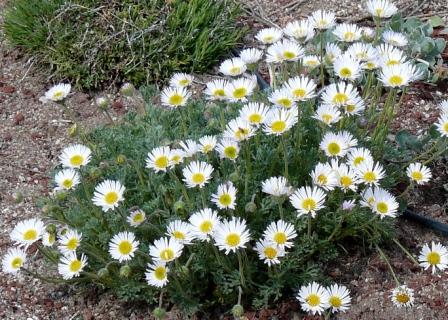Erigeron compositus in the Landscape

Diane Jones, Draggin' Wing Farm, Water-thrifty Plants for Idaho
Scientfic Name: Erigeron compositusCommon Name: Cut-leaf Daisy, Dwarf Mountain Fleabane
Description: Vigorous native fleabane that forms attractive evergreen clumps supporting numerous white to lavender daisies spring and fall. Leaves are hairy, protecting the plant from the blazing sun and constant wind of its native habitat. Very cold-hardy to zone 3 or 4.
Native Habitat: Western Canada and U.S., from Sagebrush deserts to subalpine mountain ridges.
Cultural Requirement
Soil: Any ordinary garden soil, preferably with good drainage
Moisture Tolerance: Low to very low supplemental water; does well on drip
Sun/Shade/Preference: Full sun
Transplanting: Easy
Propagation: Seed or cuttings
Maintenance (pruning, fertilization, deadheading, division, irrigation, etc): Deadhead to maintain tidy appearance and to stimulate blooming. Needs little or no fertilization.
Insect, disease, or other problems: None of concern
Landscape Value
Use in the Landscape: Outstanding in low borders or rock gardens.
Foliage: Dissected ‘mitten-like' hairy grey-green leaves in a dense basal mound
Timing: Mid May-Mid June
Color: white-lavender
Form: Clump
Texture: Woolly and dense
Ultimate Size: 6" tall by 8-10" wide
Rate of Growth: Moderate growth with supplemental water
Suggested Plant Partners: Davidson's Penstemon, Shrubby Penstemon
Availability: Available at specialty nurseries
Cultivars: None
References:
Earle, A. Scott, Idaho Mountain Wildflowers, Larkspur, 2001
Taylor, Ronald, Sagebrush Country, A Wildflower Sanctuary, Mountain Press, 1992.
Parkinson, Hilary et. al., Landscaping with Native Plants of the Intermountain Region, U.S. B.L.M. Technical Reference #1730-3, 2003.
Blackwell, Laird R., Great Basin Wildflowers, Morris, 2006.
Mee, Wendy et. al. Waterwise, Native Plants for Intermountain Landscapes, Utah State University Press, Logan 2003.

